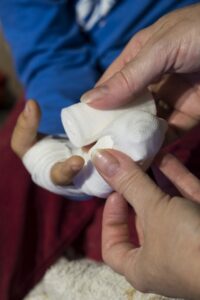
Finger fractures are a common occurrence. The good news is that they often can be treated without surgery in either a cast or removable brace.
These fractures are often more of a soft tissue injury than a bony injury. This means that the goal is often to prevent stiffness and provide a stable construct to allow early motion. Often, I see patients who have been immobilized for too long and or in the wrong position. These patients have stiff fingers which can be challenging to overcome and often require additional hand therapy. Therefore, it is important to see a hand specialist early and not delay.
Treatment options
Nonsurgical Treatment of Finger Fractures
Patients that dont have significant shorten and or rotation can be treated without surgery. The fingers are immobilized for 4 weeks and then are allowed motion.
Buddy Tape is a great way to protect the fingers and provide motion. The importance is where the fingers are buddy taped together and leaving the joints free.
Surgical Treatment of Finger Fractures
Below are examples of surgical treatment options. Each depend on the fracture type.
Metacarpal fracture that was rotation off and treated with pins
Metacarpal fracture that was treated with an intramedullary screw to allow early motion
Proximal phalnax fracture that was treated with small screws .
The treatment for a finger fracture depends on the severity of the injury. For minor fractures, splinting, casting, or buddy taping may be sufficient, while more severe fractures may require closed or open reduction. After the initial healing period, physical therapy may be necessary to help regain function and reduce pain. If you suspect you have a finger fracture, it is important to seek medical attention to determine the best course of treatment for your specific situation.
Click Here for More Information
